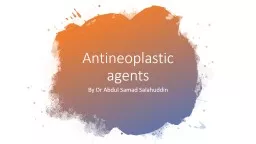

Antineoplastic agents Antineoplastic agents are drugs used for the treatment of cancer malignancy tumor carcinoma sarcoma Leukemia or neoplasm Greek neo new Plasm formation Neoplasm refers to a group of diseases caused by several agents namely chemical compounds and radiant energy ID: 909048
Download Presentation The PPT/PDF document "Antineoplastic agents By Dr Abdul Samad ..." is the property of its rightful owner. Permission is granted to download and print the materials on this web site for personal, non-commercial use only, and to display it on your personal computer provided you do not modify the materials and that you retain all copyright notices contained in the materials. By downloading content from our website, you accept the terms of this agreement.
Slide1
Antineoplastic agents
By Dr Abdul Samad Salahuddin
Slide2Antineoplastic agentsAntineoplastic agents are drugs used for the treatment of cancer, malignancy, tumor, carcinoma, sarcoma, Leukemia, or neoplasm (Greek neo = new, Plasm = formation). Neoplasm refers to a group of diseases caused by several agents, namely, chemical compounds and radiant energy. Cancer is characterized by an abnormal and uncontrolled, division of cells, which produces
tumours and invades adjacent normal tissues. Often, cancer cells separate themselves from the primary tumour, and are carried by the lymphatic system to reach distant sites of the organs, where they divide and form secondary tumors (metastasis).Not all tumors are cancerous, Benign Tumors do not Invade neighboring tissues and do not metastasize.
Slide3Slide4Slide5Slide6Slide7Limitations of TherapyCancer cells very rapidly develop resistance to antineoplastic drugs.Differences between normal and neoplastic human cells are merely quantitative.Biochemical and morphological differences between normal and neoplastic cells are slight; therefore:
antineoplastic agents are devoid of selective toxicity to tumor cells.Antineoplastic agents kill cells by first-order kinetics, that is, they kill a constant fraction of cells.However, some of the cancer cells elude killing and one of these cells may restablize the tumour. It is extremely difficult to kill all the malignant cells.Most antineoplastic drugs are highly toxic to the patients.
Slide8Classification:Antineoplastic agents are classified as follows:I. Alkylating agentsII. AntimetabolitesIII. AntibioticsIV. Plant products
V. EnzymesVI. HormonesVII. Immuno therapyVIII. Monoclonal antibodies
IX. Radio-therapeutic agentsX. Cyto-protective agentsXI. Miscellaneous.
Slide9Slide10Slide11Slide12Slide13III. Plant Alkaloidsa. Vinca Alkaloids
Slide14Slide15Slide16Trastuzumab
CisplatinCarboplatin
Slide17Mechanism of Action of Alkylating agentsAlkylating agents involve reactions with guanine in DNA. These drugs add methyl or other alkyl groups onto molecules where they do not belong. This in turn inhibits their correct utilization by base pairing and causes a miscoding of DNA.In the first mechanism an alkylating agent
attaches alkyl groups to DNA bases. This alteration results in the DNA being fragmented by repair enzymes in their attempts to replace the alkylated bases.A second mechanism by which alkylating agents cause DNA damage is the formation of cross-bridges, bonds between atoms in the DNA. In this process, two bases are linked together by an alkylating agent that has two DNA binding sites. Cross-linking prevents DNA from being separated for synthesis or transcription.
Slide18Example
N
Slide19Slide20Slide21Slide22